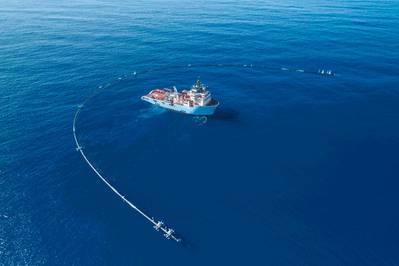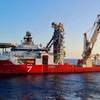The Ocean Cleanup Kicks Off
A first-of-its-kind floating ocean cleanup system is undergoing a final round of testing before it begins removing plastic pollution from the Great Pacific Garbage Patch halfway between Hawaii and California.
The system developed by the Dutch nonprofit The Ocean Cleanup was launched from San Francisco Bay on September 8 and towed 350 nautical miles by the vessel Maersk Launcher to an offshore test site. System 001 will now undergo two weeks of trials before continuing its journey to start collecting debris at the world’s largest accumulation of ocean plastic some 1,200 nautical miles off the coast of California.
The wind- and wave-propelled cleanup system consists of a 600-meter-long U-shaped floating barrier with a three-meter skirt attached below. The entire setup glides at the surface, moving slightly faster than the plastic to collect and funnel all debris at its center. The Ocean Cleanup describes the system as "a giant Pac-Man, skimming the surface of the ocean."
The first full-scale system now underway follows on hundreds of scale-model tests, a series of prototypes, research expeditions and multiple iterations. This final round of tests aims to verify the effectiveness of the system and its design and ensure it is able to withstand the conditions of the ocean before it is towed all the way out to the Great Pacific Garbage Patch.
"The installation went very smoothly, and the system seems to be behaving well so far," The Ocean Cleanup said on its website. "Configuring the system in its u-shape is the first item from our checklist that we have accomplished, and it directly matches the predicted curvature from engineering models."
Other key goals on team’s checklist include confirming that the system will move through the water faster than the plastic, proving the system will reposition itself when wind/wave direction changes, ensuring the width of the system stays in a desirable range to capture and retain plastic, and testing its ability to withstand harsh sea conditions.
Boyan Slat, Founder and CEO of The Ocean Cleanup, said, “[The] launch is an important milestone, but the real celebration will come once the first plastic returns to shore. For 60 years, mankind has been putting plastic into the oceans; from that day onwards, we’re taking it back out again.”
If all goes according to plan, first plastic will be returned to land within six months after deployment, The Ocean Cleanup anticipates. This will mark the first large-scale collection of free-floating plastic from the ocean.
The Ocean Cleanup said it plans to recycle the returned plastic into products and use the proceeds to help fund the future cleanup operations.
While System 001's primary objective is to prove the technology and start the cleanup, a secondary goal is to collect performance data to improve the design for future deployments. The system is equipped with solar-powered and satellite-connected sensors, cameras and navigation lights to communicate its position to passing marine traffic, and enable extensive monitoring of the system and the environment. The Maersk Launcher will also remain active as an observation platform for several weeks after delivering System 001 to the Great Pacific Garbage Patch.
In order to begin tackling the Pacific debris patch covering an area twice the size of Texas, The Ocean Cleanup aims to scale up to a fleet of approximately 60 systems over the next two years, depending on the results of the current system and funding availability. The group projects that the full fleet would be able to remove half of the 1.8 trillion pieces of plastic in the Great Pacific Garbage Patch within five years, in line with its ultimate goal to reduce the amount of plastic in the world’s oceans by at least 90 percent by 2040.
Slat said, “I am incredibly grateful for the tremendous amount of support we have received over the past few years from people around the world, that has allowed us to develop, test and launch a system with the potential to begin to mitigate this ecological disaster. This makes me confident that, if we manage to make the technology work, the cleanup will happen.”














